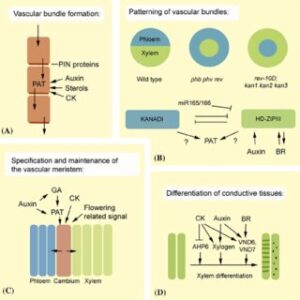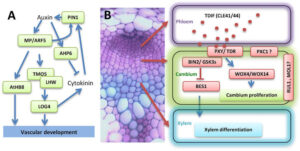Back to: Botany 300 Level
Hello, my brilliant friend! I hope you’re doing great today! Have you ever thought about how plants develop different transport tissues like xylem and phloem? Just like humans have blood vessels to carry oxygen and nutrients, plants have vascular tissues that transport water, minerals, and food. But how do these tissues form, and how do they work together to move substances?
Today, we’ll discuss vascular differentiation and transport mechanisms, so you’ll understand how plants develop an efficient transport system to stay alive and grow!
Vascular differentiation and transport mechanisms
Vascular Differentiation: How Xylem and Phloem Develop
Vascular differentiation is the process by which cells in young plants specialise to form xylem and phloem. This process begins in the procambium, a meristematic tissue found in young shoots and roots.
There are two main pathways of vascular differentiation:
Xylem Differentiation
Some procambium cells develop thick lignified walls and become xylem cells.

These cells eventually die and form hollow tubes for transporting water.
Includes tracheids and vessel elements for water conduction.
Phloem Differentiation
Other procambium cells remain alive and become phloem cells.
These cells specialise into sieve tube elements, companion cells, fibres, and parenchyma to transport food.
How Vascular Tissues Are Arranged in Plants
In dicots (e.g. mango, hibiscus), xylem and phloem form vascular bundles in a ring.
In monocots (e.g. maize, palm trees), vascular bundles are scattered throughout the stem.
Transport Mechanisms in Plants
Once xylem and phloem are formed, they use different mechanisms to move substances.
1. Water Transport in Xylem
Water moves upward from roots to leaves through three main forces:
Root Pressure – Water enters the roots and pushes upwards due to osmosis.
Capillary Action – Water molecules stick to the walls of the xylem, pulling more water up.
Transpiration Pull – Water evaporates from leaves, creating suction that pulls more water up from the roots.

Think of this like drinking juice with a straw—when you suck at the top, liquid moves up through the straw, just like transpiration pull moves water in xylem!
2. Food Transport in Phloem (Translocation)
Phloem transports food (mainly sucrose) from source (leaves) to sink (roots, fruits, and growing parts). This movement is called translocation and follows the pressure-flow hypothesis:
Sugar is loaded into the phloem at the source, creating high pressure.
Water from the xylem enters the phloem, pushing sugar towards the sink.
Sugar is unloaded at the sink, and pressure decreases.
Water returns to the xylem, maintaining a continuous cycle.
Imagine a water balloon: when you squeeze one end, the water moves to the other side. That’s how pressure pushes sugar through the phloem!
Summary
Vascular differentiation is the process where young cells become xylem (for water transport) or phloem (for food transport).
Xylem and phloem are arranged in different patterns in dicots and monocots.
Xylem transports water using root pressure, capillary action, and transpiration pull.
Phloem transports food through translocation, following the pressure-flow hypothesis.
Evaluation
- What is vascular differentiation?
- How do xylem and phloem develop from procambium?
- What are the three main forces responsible for water transport in xylem?
- Explain the pressure-flow hypothesis in phloem transport.
- How is vascular tissue arranged in monocots and dicots.
You are doing an amazing job! Now, you understand how plants develop their transport system and how water and food move inside them! Keep observing plants around you—you’ll start seeing how vascular tissues keep them alive. Keep learnin gwith Afrilearn, and I’ll see you in the next exciting lesson. Stay curious and keep growing!
